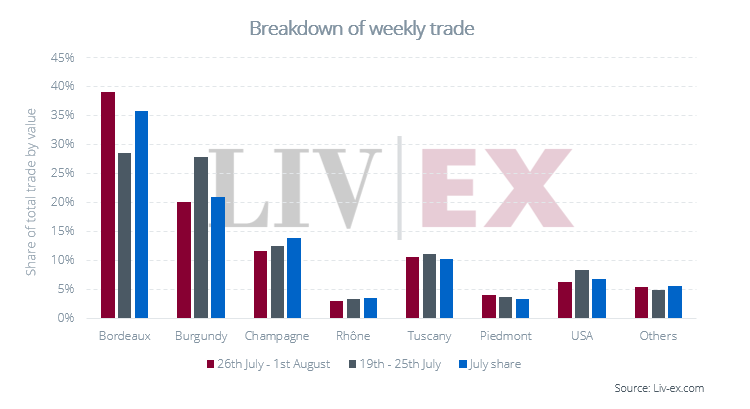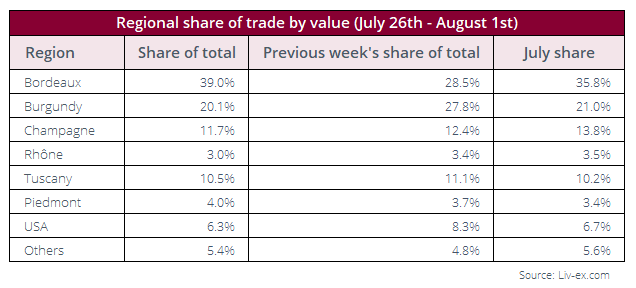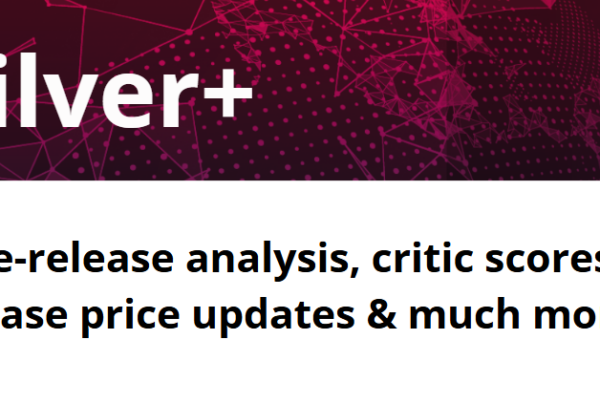- Bordeaux led trade this week, followed by Burgundy, Champagne, Tuscany and the USA.
- The top five traded wines this week hailed from Bordeaux, Burgundy and Tuscany.
- This week, Liv-ex published a Market Update on how we can expect the recent UK interest rate cut to affect the fine wine market.
What’s happening in the market?
While Burgundy came close to overtaking Bordeaux last week, the latter region has bounced back, taking a 39.0% share of value. The region saw trade of several mature, high-value wines, including Petrus 1989, Château Mouton Rothschild 1945 and Château Haut-Brion 1998.
Burgundy’s trade share dropped from 27.8% to 20.1%. Still, the region saw high-value trades of Domaine de la Romanée-Conti and Domaine Leroy, and was bolstered by high-volume trades of Marquis d’Angerville’s Clos des Ducs.
Champagne came in third, with an 11.7% share of trade. While Pol Roger’s Sir Winston Churchill 2015 was the top-traded wine in the region, Dom Pérignon and Salon proved the most popular producers overall.
Tuscany’s trade share was down slightly on last week. The region is usually led by Super Tuscans, but Brunellos saw an uptick in demand this week. Biondi-Santi Brunello di Montalcino Riserva 2016 was the top traded wine by value from the region. Altesino’s Brunello di Montalcino Riserva 2016 also saw significant trade.
Screaming Eagle Cabernet Sauvignon 2021 has consistently been the top-traded Californian wine this year but did not see any trade this week. Instead, Promontory 2017 and Harlan 2015 led the charge.
Remy Martin, Louis XIII Cognac also traded this week at £2,003 per 1×70 – 13.0% below its Market Price.
What were the top-traded wines this week?
The top-traded wine by value this week was the 1989 vintage of Petrus. While in 2023 Neal Martin (Vinous) rescored the wine 99 points, down from his previously given 100, he described it as ’effortlessly harmonious’ and ’magnificent’. Given the wine’s age and Petrus’s famously low production numbers, it is not easy to come by and has sold more frequently at auction than on the exchange. The wine’s rarity has somewhat protected its price from the broader market’s downturn. Still, given Petrus’s high price point, even slight price movements can result in large gains (or losses).
Auctions and Liv-ex trades of Petrus 1989
Biondi-Santi’s 2016 Brunello di Montalcino Riserva took the second spot. The wine has been trading regularly since entering the market and, relative to the broader market, has retained its value well. Château Latour 2011 came in third, trading at a 9.5% discount to its Market Price. The wine was last bought for £3,800 – a return to the pricing lows of 2016.
Liv-ex trades of Latour 2011
Two high-value Burgundies also ranked amongst the top five – Domaine de la Romanée-Conti’s Romanée-Conti Grand Cru and Domaine Leroy’s Romanée-Saint-Vivant Grand Cru. While we have reported on white Burgundy’s relative stability, reds from the region remain marginally more popular. This week, 43.4% of cases bought from the region were white.
Top-traded wines by volume
While the Rhône’s share of trade value this week decreased from last week’s, the top-traded wine by volume hailed from the region. Large-volume buyers were diverse in their purchasing habits. The top wines hailed from four different regions and ranged from £55 – £1,440 per 12×75.
Weekly insights recap
This week, Liv-ex members were sent a Market Update, on the impact of the UK interest rate cut on the fine wine market. Next week, we will publish our August Market Report, alongside an update on the major Liv-ex indices.
Liv-ex analysis is drawn from the world’s most comprehensive database of fine wine prices. The data reflects the real-time activity of Liv-ex’s 620+ merchant members from across the globe. Together they represent the largest pool of liquidity in the world – currently £100m of bids and offers across 20,000 wines.









